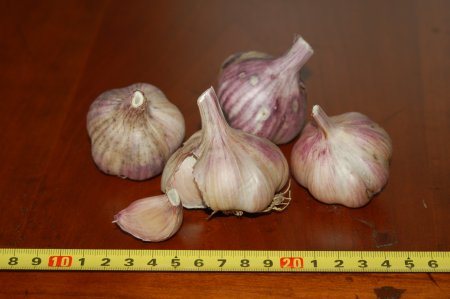Almost a month ago I made a post on this topic, and I asked people to let me know what their personal experiences were. As well as making the post, I sent out some emails and I had some previous discussions with people on the subject. In total I got information from 10 garlic growers all over the world, including myself.
One of the first things I noticed was initially I didn’t get any response from anyone in the US growing garlic, and I had to send some emails and pose the question directly to some garlic growers there. It turns out the reason I didn’t get much reaction from them is garlic rust is just not much of an issue in that region. Rust is only present in a few parts of California and Arizona, and otherwise not in North America. The information I have suggests it is also not present in New Zealand.
It is not possible to draw solid conclusions from the information people sent me. Manure was used from a variety of different animals, at different times in the garden cycle, sometimes it was used fresh and sometimes composed or aged first for different amounts of time.
Under these circumstances, all it’s possible to do is try to look at everything everyone sent me in the broadest and hopefully open minded of ways, and give my opinion about what it all meant in a very unscientific way. In this spirit, what I can say is that with a few exceptions most people who lived in an area where rust was a problem and used manure on their garlic experienced serious rust, and those who didn’t use manure the rust was much less serious.
In addition, a garlic grower in the US send me a link to this publication from the Oregon State University that most importantly says too much nitrogen in your garden can stress the plants and make garlic rust worse.
Growing up in the US I have always been told most home gardens don’t need anything added to them except recycled plant material in the form of compost. You should always rotate your crops, but even the most poorly planned rotation schemes will generally keep nutrients balanced in your garden as long as you are also adding some compost.
It is possible, but not likely, that your garden is lacking some nutrient or combination of nutrients. Unless you know this from a soil test or some other way, you should not add any kind of fertilizer or soil conditioner, organic or otherwise, because you risk upsetting the natural balances in your garden and stressing your plants.
Adding fresh manure (or chemical fertilizers) can be a particular problem because the nitrogen it contains is primarily soluble nitrogen. Naturally occurring nitrogen is usually fixed. The main difference is soluble nitrogen is absorbed much more quickly by the plants (and in this way can easily kill them), whereas plants tend to absorb fixed nitrogen only as it’s needed. This quick absorption of the nitrogen can make the plants grow fast giving us the feeling we are feeding them and making them healthy, when in fact we can be damaging them. The same thing is true with phosphorus, because there are fast and slow acting versions of it. The fast acting versions of the phosphorus can give you similar problems as with soluble nitrogen.
This is what is sometimes referred to as feeding your plants instead of feeding your soil. It’s always better to feed your soil by adding things like compost or growing nitrogen fixing plants, then it is to think along the lines of vitamins and feed your plants NPK (nitrogen, phosphorus, potassium) fertilizers.
For farmers the situation is different, because they often have commercial reasons why they don’t rotate their crops, and they have to deal with economic realities requiring cosmetics and yield on a cost basis. Farmers also usually use commercial varieties of crops which often require special applications of fertilizers and pesticides. Farmers also often have animals and need a way to deal with the waste. We grow things differently and under different circumstances in our gardens.
This year I have purchased a Soil Testing Kit, and I hope to use it to get some information about my garden. I am certain soil testing will not be the end of the story. Nutrients in your garden can vary greatly from spot to spot and season to season, and is also very dependent on what fertilizers have been used in the past as well as what plants have been grown. At the same time, I hope testing the soil will give me an idea if there are any serious problems. I’ll be posting about my results.
Søren and I have been discussing this in email, and he has pointed out there are other ways besides chemical tests to determine if there are nutrient imbalances in your garden. Experienced gardeners can tell just by the way certain plants grow.
For example, you can tell by how brown your garlic gets if you have too much nitrogen in your garden!
Bare Bones Gardener posted not too long ago about using hydrangeas to tell if your soil is acidic or not.
I hope some more people do posts about these kinds of plants, because in the long run this is obviously a better solution than a chemical soil test.


